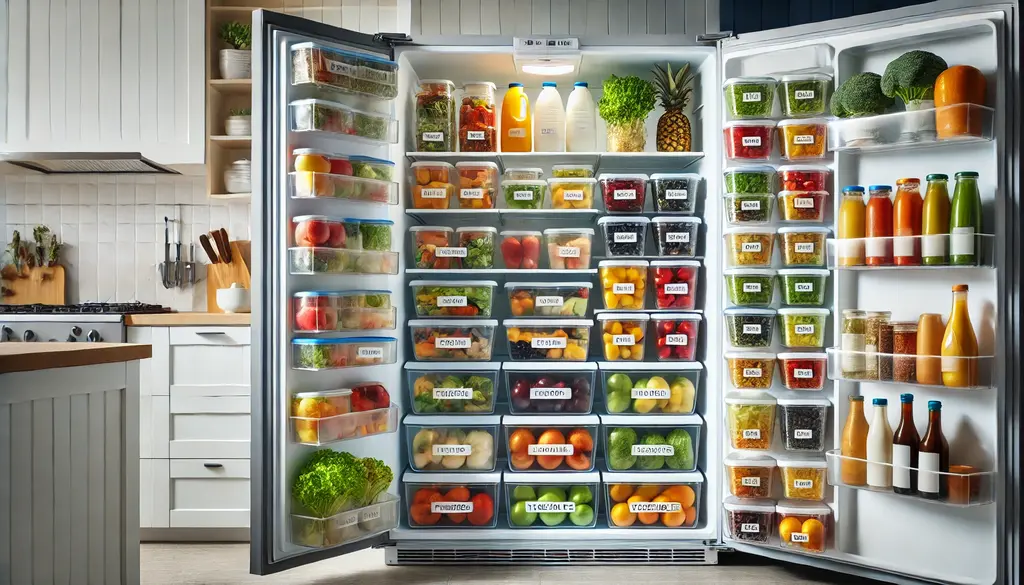A refrigerator is more than just an appliance—it’s the heart of your kitchen. It’s where meals begin, snacks are found, and groceries are stored. But if your fridge is disorganized, it can quickly turn into a source of stress rather than convenience. From forgotten leftovers to spilled condiments, a messy refrigerator can cost you time, money, and even your peace of mind.
Organizing your refrigerator isn’t just about aesthetics—it’s about creating a functional, efficient system that makes cooking easier, food fresher, and your kitchen a happier place to be. In this guide, we’ll take a deep dive into how to clean, organize, and maintain your fridge to maximize its potential.
You may also like this: Choosing the Right Kitchen Appliances: Efficiency Meets Style
Why Organizing Your Refrigerator Matters?
An organized fridge saves you time by making it easier to find what you need when you need it. It saves you money by helping you avoid wasting food that expires before you notice it. It also promotes food safety by reducing the risk of contamination between raw and ready-to-eat items. Beyond these practical benefits, having a well-organized refrigerator can also lower your stress levels and make cooking and meal prep more enjoyable.
Think about it: how often have you bought something you already had, simply because you couldn’t see it in your cluttered fridge? How many times have you thrown out produce that spoiled in a forgotten corner? Organizing your fridge isn’t just a task—it’s an investment in your household’s efficiency and well-being.
How to Successfully Organize Your Refrigerator?
Here is our step-by-step process for organizing your refrigerator:
Step 1: Start Fresh With a Deep Clean
Before you can organize your refrigerator, you need to start with a clean slate. Empty your fridge, placing perishable items in a cooler with ice packs. Throw away anything that’s expired, spoiled, or questionable. Use this opportunity to evaluate what you use and what tends to go untouched.
Once everything is out, clean your refrigerator thoroughly. Remove shelves and drawers, and wash them with warm water and dish soap. Wipe down the interior with a mixture of water and baking soda or vinegar to tackle odors and stains. Pay special attention to nooks and crannies where crumbs and spills tend to collect. A clean fridge is not only more hygienic but also makes organizing easier and more effective.
Step 2: Map Out Your Refrigerator Zones
Not all areas of your refrigerator are created equal. Different zones within your fridge are better suited to different types of food, depending on their temperature and humidity levels. Organizing your fridge based on these zones can significantly extend the life of your food.
- Top Shelves: These are ideal for items that don’t need the coldest temperatures, such as beverages, leftovers, and ready-to-eat foods like deli meats and prepared meals. The even temperature on the top shelves keeps these items fresh without freezing them.
- Middle Shelves: Use the middle shelves for dairy products like milk, yogurt, and cheese. These items need a stable, consistent temperature to stay fresh longer.
- Bottom Shelves: The bottom shelves are the coldest part of the fridge, making them perfect for storing raw meats, seafood, and poultry. Always place these items in leak-proof containers or on trays to prevent juices from dripping onto other foods.
- Crisper Drawers: Designed to maintain specific humidity levels, crisper drawers are the best place for fruits and vegetables. Adjust the humidity settings—high humidity for vegetables and low humidity for fruits—to keep them fresh longer.
- Door Shelves: The door is the warmest part of the fridge because it’s exposed to air every time you open it. Store condiments, sauces, and juices here, but avoid placing perishable items like eggs and milk on the door.
Step 3: Optimize Storage With Smart Solutions
The right storage tools can make a world of difference in how your refrigerator functions. Start by investing in clear, stackable containers that let you see what’s inside without opening them. These are great for leftovers, pre-chopped produce, or pre-portioned snacks.
Consider using bins to group similar items. For example, dedicate one bin to breakfast essentials like butter, cream cheese, and jam, and another for salad ingredients. Lazy Susans can help keep jars and bottles easily accessible, preventing them from getting lost in the back of the fridge.
Label your containers to make identifying contents quick and easy. If you store leftovers, add the date so you know when they need to be eaten. This simple step helps reduce food waste and keeps your fridge organized.
Another trick is to utilize vertical space with shelf risers or stackable bins. These tools create extra layers, allowing you to store more without overcrowding.
Step 4: Follow the First In, First Out (FIFO) Rule
The FIFO system is a must for anyone looking to keep their refrigerator organized. It’s simple: place newer groceries behind older ones. This ensures you use up older items first and prevents food from being forgotten and expiring.
When unpacking groceries, take a moment to rotate your items. For instance, if you’ve bought a new carton of milk, place it behind the one that’s already open. This small habit can save you money and reduce waste over time.
Step 5: Maintain Your Organized Fridge
An organized fridge isn’t a one-and-done project—it requires consistent upkeep. Set aside time each week to do a quick fridge check. During this time, toss expired items, wipe up any spills, and reorganize as needed. Doing this regularly prevents clutter from building up and keeps your fridge functioning at its best.
Make it a habit to clean as you go. If you notice a spill or crumbs, clean it immediately to prevent odors and bacteria from developing. A little maintenance goes a long way in keeping your fridge neat and fresh.
Step 6: Avoid Common Mistakes
Even with the best intentions, there are a few mistakes that can undermine your efforts to organize your refrigerator. Avoid these pitfalls:
- Overcrowding: Packing your fridge too full prevents proper air circulation, making it harder for your fridge to keep everything at the right temperature. Leave space around items to allow air to flow freely.
- Improper Placement: Never store highly perishable items, like milk or eggs, in the door. These foods need the consistent temperature on the main shelves.
- Ignoring Expiration Dates: Regularly check the dates on your items to avoid keeping expired food. A clutter-free fridge is a safer fridge.
Step 7: Encourage Healthy Eating
An organized fridge can also promote healthier eating habits. When nutritious foods like fresh fruits, vegetables, and yogurt are easy to see and access, you’re more likely to choose them over less healthy options. Place these items at eye level to make them the first thing you see when you open the fridge. Pre-wash and portion produce for grab-and-go convenience and keep unhealthy snacks out of sight to reduce temptation.
Step 8: The Long-Term Benefits
Once your refrigerator is clean, organized, and well-maintained, you’ll start to see the long-term benefits. Meal prep becomes faster and less stressful because you know exactly where everything is. You’ll save money by reducing food waste and avoiding duplicate purchases. And perhaps most importantly, you’ll feel more in control of your kitchen.
Conclusion
Organizing your refrigerator may seem like a daunting task, but the payoff is worth it. By following these steps—cleaning your fridge, understanding its zones, optimizing storage, and maintaining your system—you’ll create a space that supports your lifestyle and makes your kitchen a more efficient, enjoyable place. Start small, and remember that consistency is key. With a little effort, you can transform your refrigerator into a well-oiled machine that saves time, money, and stress. An organized fridge is more than just a tidy appliance—it’s a tool for a better, healthier life.

